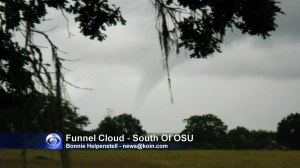 It’s rare–but wild weather happens in the northwest.
It’s rare–but wild weather happens in the northwest.
This picture shows a well formed funnel cloud about 15 miles due south of Oregon State University on the afternoon of Thursday June 13, 2013.
As far as we know, it never touched down. So that’s why we call it a funnel cloud. We’d call it a tornado if it went all the way to the ground. Which leads us to McMinnville, where a confirmed EF-1 hit.
Rare EF-1 Tornado Hits Part Of McMinnville, Oregon
I was doing the 4 o’clock news on KOIN 6 (as usual) when I barely noticed this shower cell developing.
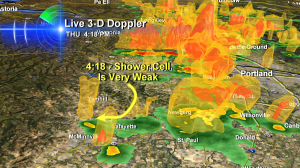 At 4:18pm, I was much more interested in the showers over Beaverton, just west of Portland. You can sure see why on our 3-D Doppler. The McMinnville cell was basically nothing.
At 4:18pm, I was much more interested in the showers over Beaverton, just west of Portland. You can sure see why on our 3-D Doppler. The McMinnville cell was basically nothing.
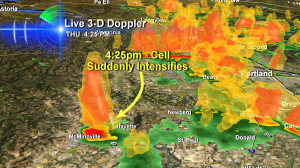 Then just 7 minutes later, the cloud top shot up to 13,000′ in the sky as the shower suddenly became intense. Still, on cold northwest shower days, this is not all that unusual. Nonetheless, I did show the shower over McMinnville at that point because it was causing quite a downpour.
Then just 7 minutes later, the cloud top shot up to 13,000′ in the sky as the shower suddenly became intense. Still, on cold northwest shower days, this is not all that unusual. Nonetheless, I did show the shower over McMinnville at that point because it was causing quite a downpour.
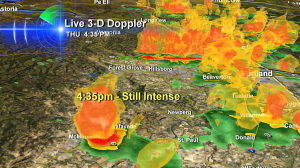 By 4:35pm the storm was more broad and more powerful. Although there was never any sign of rotation on the radar, we know now that the tornado was on the ground at 4:33pm. An eyewitness we talked to on KOIN 6 News told us he saw the tornado on the ground for about 15 seconds, along with pieces of debris flying in the air.
By 4:35pm the storm was more broad and more powerful. Although there was never any sign of rotation on the radar, we know now that the tornado was on the ground at 4:33pm. An eyewitness we talked to on KOIN 6 News told us he saw the tornado on the ground for about 15 seconds, along with pieces of debris flying in the air.
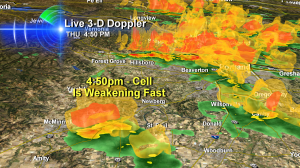 By 4:50pm, the storm cell is collapsing and returning to a typical ‘northwest shower’. The event, and any danger, is over.
By 4:50pm, the storm cell is collapsing and returning to a typical ‘northwest shower’. The event, and any danger, is over.
Top windspeeds with ths tornado were found to be low end EF-1 (the range of an EF-1 is 86-110mph) with peak winds of 86-90mph. Thankfully, no one was hurt.
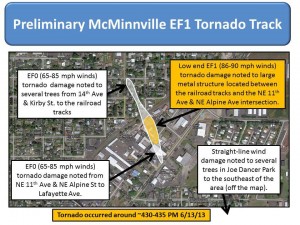 Here’s the tornado track and damage map put together by the National Weather Service in Portland. Investigators from this office raced down to McMinnville as soon as reports came in of the damage and possible tornado. The tornado track was from NNW to SSE or top to bottom on this map.
Here’s the tornado track and damage map put together by the National Weather Service in Portland. Investigators from this office raced down to McMinnville as soon as reports came in of the damage and possible tornado. The tornado track was from NNW to SSE or top to bottom on this map.
Oregon And Washington Tornado Rankings By State
If you’ve lived here for long–you know an Oregon or Washington tornado is a big deal. Anytime they happen! I did some digging in the Storm Prediction Center’s tornado database and this is how Oregon & Washington rank for total number of tornadoes from 1980-2009, the most recent compiled stats I could find:
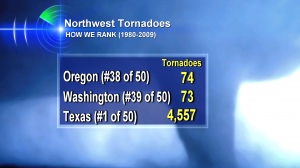 Both of our states have had fewer than 100 tornadoes in 30 years. Oregon ranks 38th out of 50 states and Washington ranks 39th out of 50 states. But Texas, well, it’s the number one tornado state in the U.S. with 4,557 tornadoes during the same 30 year span. Everything really is big in Texas! I made this graphic because I think it really puts things into perspective.
Both of our states have had fewer than 100 tornadoes in 30 years. Oregon ranks 38th out of 50 states and Washington ranks 39th out of 50 states. But Texas, well, it’s the number one tornado state in the U.S. with 4,557 tornadoes during the same 30 year span. Everything really is big in Texas! I made this graphic because I think it really puts things into perspective.
So, it was an interesting June 13, 2013. The first funnel cloud was spotted near Corvallis, Oregon around 1:30pm, a sign that things were unstable as unusually cold air moved into our skies along with a ‘nearby’ area of low pressure. About 4:30pm, there was another funnel cloud spotted near Harrisburg in the southern Willamette Valley. Then we had the McMinnville tornado with estimated touchdown about 4:33pm and finally a third funnel cloud spotted just southeast of the Hillsboro airport at about 5:05pm. All of these, including funnel clouds, are rare but pop up from time to time. Thankfully, there’s been no repeat of the northwest’s deadliest tornado on record.
It was the kind of day where these “cold core funnels” and thunderstorms can form, although there was no lightning or thunder with these cells west of the Cascades. But the real question is why did the McMinnville cell suddenly develop an actual tornado? That will likely be answered in the weeks to come as everything about the weather from that moment is analyzed.
Remember the Aumsville, Oregon tornado a few years ago? Storm Meteorologists at the National Weather Service finally figured out this was caused by three disturbances that randomly merged, if you will, to create something unexpected and dangerous. There’s no way to predict that will happen ahead of time in our northwest skies.

Hey Bruce,
I am just curious about the funnel clouds and tornadoes that we have been having over the last 10 years or so. Do you think they are becoming more common as time goes on and if so why?
Teia–
Sorry for the delay in answering your question. Longterm, Oregon & Washington average 2 tornadoes a year. But if you look at the last 30 years, that average has jumped to 3 per year. And nationally, there are more tornadoes documented — an upward trend, overall, even though each individual year can be up or down. The ‘average’ line is headed up.
Is it climate change? Could be. Is it the fact that more people live more places? Could be. Is it that no tornado goes un-seen between an army or mid-west storm chasers and iPhone toting Oregonians & Washingtonians? Sure could be!
So, more documented tornadoes? Yes. What’s the significance and the cause? Stay tuned as I like to say, stay tuned. And thanks for your questions and facebook posts, etc. I hope you’re surviving the heat! Bruce